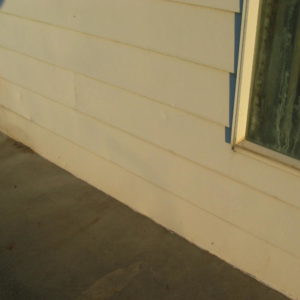Ok, working on a 1977 Ranch with daylight basement, three quaters of the house is sided in brick with the backwall ( daylight part) sided in aluminum siding. Everything is on footings but the back side which is a poured slab and the wall is framed directly on this. The siding goes right down to the slab and is caulked to the slab “nice”. There is also a ten foot poured patio so no direct contact with soil. About 50% of the back side of the wall is unfinished space so you can see the studs no rot or crawly things present.
The back side is going to be re-sided but material is yet to be determined. Choices are: 3-4′ brick wainscotting then Hardi above that ( but hard to match 30 year old brick), all Hardi, or a stucco finish.
My question is how to do this correctly? If re-sided in hardi and a “L” flashing is put in place it still needs caulk or something to keep driven water from getting under the flashing. Brick seems to give it more of a barrier but still need to keep moisture from moving back. My knowledge with Stucco is limited, I have always seen a metal drip channel on the bottom but that was for a house on a footing and the stucco was 6″ minimum from the ground.
This place is in Eastern Washington the dry part but we get our fair share of rain and snow. I find it hard to believe this passed an inspection but 30 years ago this place was in the middle of the wheat fields. It still is out in the county.
One other thing the back side will get a deck above it running almost the whole side.
Any thoughts thanks
Jeff




















Replies
Don't try to match the brick. That never comes off well.
use some man-made stone applied to wire lath over ice and water shield up to base of window. Make a beveled sill extension that also runs the top of this waist wall at about 13-15° to shed water. Then a flashing, and your other siding on up above backed up by the right housewrpap
Welcome to the
Taunton University of Knowledge FHB Campus at Breaktime.
where ...
Excellence is its own reward!
What your picture shows is sooo wrong and soo common. A lot of these jobs has the mudsill at the slab level or below. Because the adjacent slab/dirt is not 4" to 6", we get problems with termites and moisture.
Normally the adjacent dirt is 6" lower than the top of the slab. When a patio slab is added, there should be a 2" gap between the top of the slab and mudsill/weep screed/siding. Due to laziness and/or ignorance the patio slab is too high. No amount of caulking and flashing will keep moisture out.
Lots of Contractors will install flashing that is caulk to the wall and then the slab poured against it. Later I find moisture and termite trails between the flashing and cement. I see this more with pool decks where splashing aggravates things more.
What I recommend is saw cutting the slab 4" - 6" away from the house. This gutter will carry water from the back, down the sides and to the front(Lots of lots aren't' graded right to do this). So the siding/stucco will hang 1" lower than the slab, but will still have a few inches of drying area to the dirt.
My neighbor has a back room like that. It was a porch at one time.
i don't like seeing wood/siding on grade like that , but to reall fix it it becomes a big deal and it's lasted 40 yrs...
get the siding off,any signs of rot replace with some pressure treated,caulk. then run some ice and water down and let it turn onto the patio,then a L shaped flashing,caulked to the cement with a urethane. then the hardi board,i would try and keep it off the patio maybe a 1/4".i wouldn't caulk that gap
then when you build the deck i would try and make the first 4' waterproof so that it at least gets the splash out there a bit.
fine homebuilding,probably not,maybe it last another 40? 20? ,fix it again before you head to nursing home.lol larry
if a man speaks in the forest,and there's not a woman to hear him,is he still wrong?
Thanks for the replies, that's about what I had for ideas too. Not crazy about any of them but like it was said it has done well for 30+ years. The other thing I could do is rip out the patio and grade the yard down poses two problems the septic is right there and I'm sure the wife would think that's not necessary. I'm starting to dislike remodels and fixing other people's poor work.
I'd be tempted to make a saw cut as close as possible to the wall and fit a Z flashing into that, if you don't go the brick route.
(No reason that new brick needs to match old -- someone with a good eye for colors can pick out a nice contrasting color.)
You mean cut the concrete stuff one end down, tuck the other behind the siding? That could work just wonder if it would effect the slab down the road.
Thanks Jeff
Yeah, my main concern would be that you were creating a "relief cut" that would almost guarantee a crack there -- I'll defer arguing that one way or another to the concrete gurus here. But somehow you want to assure that no water will run under the flashing. Maybe you could epoxy something down somehow.
The mark of the immature man is that he wants to die nobly for a cause, while the mark of a mature man is that he wants to live humbly for one. --Wilhelm Stekel